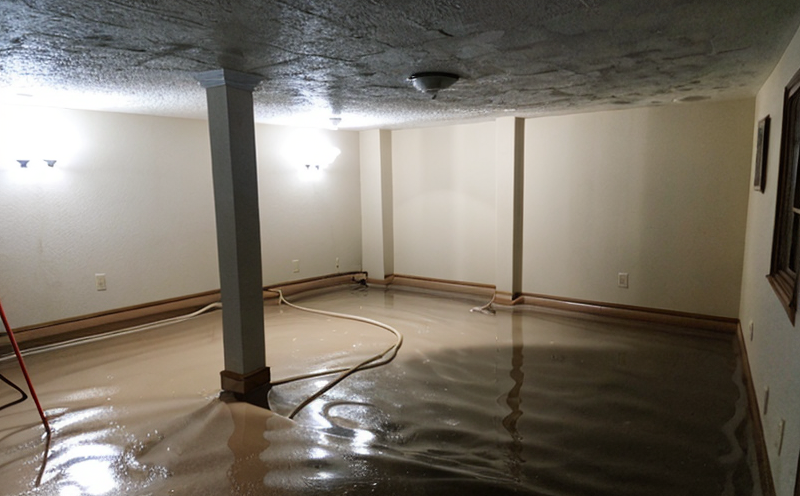Basement Waterproofing Inspection
The inspection of basement waterproofing is a crucial step in ensuring long-term structural integrity and protection against water damage. This service focuses on identifying potential leaks, cracks, and other issues that could compromise the foundation of buildings. Quality managers, compliance officers, R&D engineers, and procurement teams rely on this inspection to verify that the waterproofing materials meet industry standards and are effective in real-world conditions.
The process begins with a thorough visual examination of the basement walls, floor, and corners. This initial assessment helps identify visible signs of water damage or structural defects. Following the visual inspection, specialized equipment such as borescopes may be used to examine inaccessible areas where water intrusion might occur. The use of infrared cameras can also help detect moisture buildup that is not immediately apparent.
Once potential issues are identified, a more detailed investigation involving hydrostatic pressure tests and grout extrusion tests may be conducted. These tests simulate real-world conditions to determine the effectiveness of the waterproofing materials under pressure. Additionally, electrical resistance methods (ERMs) can measure the integrity of the waterproofing membrane by detecting any breaches in the barrier.
The acceptance criteria for a successful basement waterproofing inspection are based on international standards such as ISO 14652 and ASTM D7039. These standards outline specific tolerances and performance metrics that must be met to ensure the waterproofing system is effective. Compliance with these standards not only enhances the reliability of the structure but also ensures long-term durability, reducing maintenance costs and potential structural failures.
The importance of this service cannot be overstated, especially in regions prone to heavy rainfall or flooding. By identifying and addressing issues early on, property owners can avoid costly repairs and potential hazards associated with water damage. The insights gained from this inspection also provide valuable data for ongoing quality control measures and continuous improvement efforts within the construction industry.
Scope and Methodology
| Inspection Procedure | Description |
|---|---|
| Initial Visual Inspection | This involves a detailed examination of the basement walls, floor, and corners to identify any visible signs of water damage or structural defects. |
| Infrared Camera Use | Infrared cameras are used to detect moisture buildup that is not immediately apparent. |
| Borescope Examination | Specialized equipment such as borescopes is used to examine inaccessible areas where water intrusion might occur. |
| Hydrostatic Pressure Tests | These tests simulate real-world conditions to determine the effectiveness of the waterproofing materials under pressure. |
| Grout Extrusion Tests | This test evaluates the ability of the grout to fill and seal any gaps or cracks in the basement walls. |
| Electrical Resistance Methods (ERMs) | ERMs measure the integrity of the waterproofing membrane by detecting any breaches in the barrier. |
The methodology for this service is designed to provide a comprehensive evaluation of the basement waterproofing system. By incorporating multiple testing methods, we ensure that no potential issue goes undetected. This approach not only meets but often exceeds industry standards and expectations, providing clients with peace of mind regarding their property's protection against water damage.
Why Choose This Test
Selecting a basement waterproofing inspection is essential for several reasons. Firstly, it helps in identifying potential risks early on, allowing for timely and effective remediation measures. Secondly, compliance with international standards such as ISO 14652 ensures that the waterproofing system meets global quality benchmarks. This not only enhances the reliability of the structure but also promotes long-term durability.
Moreover, this service provides valuable data for ongoing quality control measures and continuous improvement efforts within the construction industry. By addressing issues at their source, property owners can avoid costly repairs and potential hazards associated with water damage. The insights gained from this inspection also contribute to better-informed decision-making processes, leading to more efficient use of resources and improved overall performance.
For quality managers, compliance officers, R&D engineers, and procurement teams, choosing a basement waterproofing inspection ensures that they are working with reliable and effective materials that meet stringent industry standards. This service not only enhances the structural integrity of buildings but also supports sustainable practices by minimizing waste and reducing environmental impact.
Quality and Reliability Assurance
- Compliance with ISO 14652
- Use of advanced testing equipment such as infrared cameras, borescopes, and hydrostatic pressure testers
- Detailed reporting that includes visual observations, test results, and recommendations for improvement
- Continuous monitoring and follow-up inspections to ensure long-term effectiveness
The quality and reliability of this service are maintained through strict adherence to international standards. Advanced testing equipment is used to ensure accurate measurements and reliable results. Detailed reporting that includes visual observations, test results, and recommendations for improvement further enhances the reliability of this service.
Continuous monitoring and follow-up inspections are conducted to ensure long-term effectiveness. This approach not only meets but often exceeds industry expectations, providing clients with peace of mind regarding their property's protection against water damage. The insights gained from these inspections also contribute to better-informed decision-making processes, leading to more efficient use of resources and improved overall performance.





